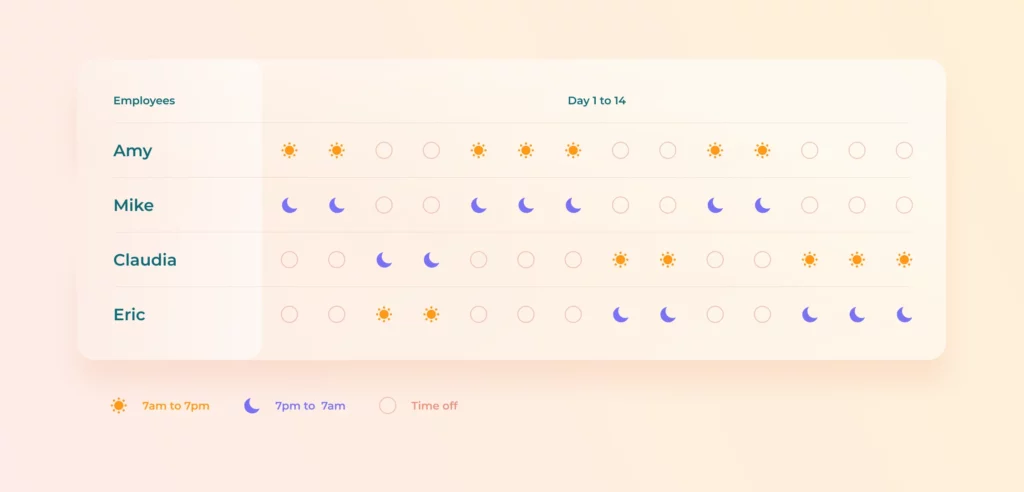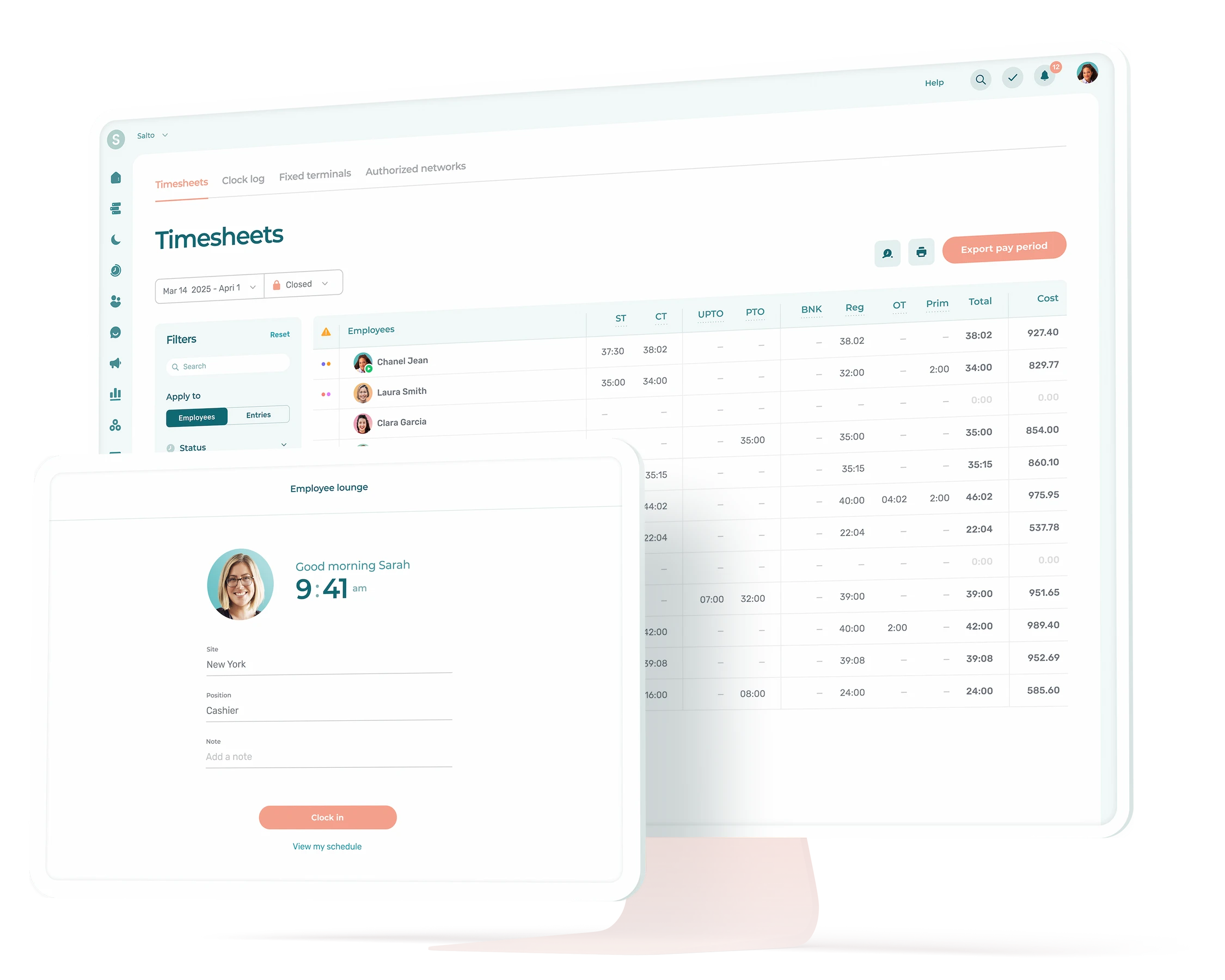Businesses that implement the right work schedule enjoy better employee morale, productivity, and job satisfaction.
They also have improved customer service, higher employee retention rates, and ultimately, greater profitability. This article explains the pros, cons and how-tos of implementing a 2-2-3 work schedule.
What Is a 2-2-3 Shift Schedule?
A 2-2-3 shift schedule, also known as a Panama schedule, is a shift pattern used in industries requiring round-the-clock staffing. Employees work 12-hour shifts for two consecutive days, followed by three consecutive days off, and then work for three consecutive days, followed by two consecutive days off. This pattern repeats continuously with 12-hour shifts during both day and night, with each employee working a total of seven days out of every 14-day period.
A 2-2-3 work schedule offers several benefits for employers and employees. It’s an effective way to ensure that an organization has enough staff coverage, while maintaining a healthy and engaged workforce.
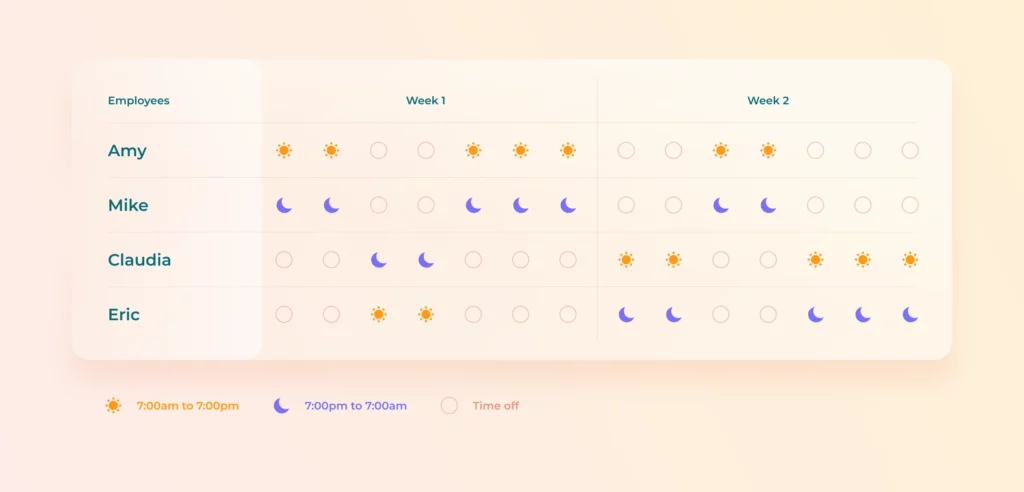
If you’d like to learn more about creating a 24-hour shift schedule for your business, check out our guide: How to Create a 24-Hour Shift Schedule for Your Business + Tips.
Which Industries Use 2-2-3 12-Hour Shift Schedules?
The 2-2-3 work schedule, is commonly used in industries that operate around the clock, such as:
- Healthcare
- Manufacturing
- Transportation
- Emergency services
- Call centers
Pros of Using a Panama Schedule
1. Continuous Coverage
A Panama schedule allows organizations to maintain continuous coverage while minimizing employee burnout and fatigue. Employees have regular and predictable time off, which can lead to improved job satisfaction and productivity.
2. Cost Savings
The schedule can help organizations save on labor costs by avoiding the need to hire additional staff to cover shifts.
3. Organized and Productive Workplace
The 2-2-3 schedule can lead to a more organized and productive workplace, as employees are less likely to experience fatigue and have time to recover during their days off.
4. Flexibility
A Panama shift schedule can offer flexibility to employees. Some workers are early risers who prefer to begin work before 9 am. Others like having the freedom to schedule personal appointments and activities during their days off without interfering with their work schedules. This can improve employee well-being.
Cons of Using a 2-2-3 Work Schedule
Some of the drawbacks of working a 2-2-3 work schedule for employees include:
1. Difficulty Adjusting
Employees used to a traditional work schedule may find adjusting to a 2-2-3 shift schedule difficult. Other employees may struggle to adapt to the longer 12-hour shifts.
2. Limited Flexibility
A 2-2-3 schedule may not be suitable for all employees or all job roles. Some positions may require different schedules or shorter shifts. Since employees work different shifts and have different days off, they will regularly have to work weekends.
3. Potential Health Effects
Another major downside is the physical and mental exhaustion of working consecutive 12-hour shifts. Shift work has been associated with negative health effects and impacts on the human circadian rhythm. The 2-2-3 shift schedule can help to minimize some of these effects by providing longer stretches of time off.
4. Reduced Productivity
While the 2-2-3 schedule can lead to a more organized and productive workplace, some employees may struggle to maintain the same level of productivity throughout a 12-hour shift. This could potentially lead to reduced productivity, lower quality work and possibly, higher risk of safety issues or costly mistakes.
5. Communication Challenges
With employees working different shifts and having different days off, it can be more challenging to maintain clear communication and collaboration among team members. This could potentially lead to miscommunications, delays, or other issues.
💡TIP: Use an internal communication platform to keep the lines of communication open, professional and clear.
6. Increased Complexity
The 2-2-3 schedule can be more complex to manage than a traditional work schedule. Managers may need to track multiple shifts and ensure that all employees are properly scheduled, which can be time-consuming and may require more resources.
💡TIP: Optimize labor costs and the allocation of human resources with employee scheduling software.
2-2-3 Pattern Variations & Alternatives
There are several variations of the 2-2-3 work schedule that organizations can use to better meet the needs of the company and its staff.
- Variation #1: The Pitman schedule
- Variation #2: The DuPont schedule
- Variation #3: The DDNNOO schedule
Pitman Schedule
What Is a Pitman Schedule?
The Pitman shift schedule is a type of work schedule that involves four teams working 12-hour shifts over a two-week period. This allows for your business to operate around the clock while also promoting productivity and employee satisfaction. There are two variations of a Pitman shift schedule: the Pitman fixed schedule and the rotating shift Pitman schedule.
How the Pitman Rotating Schedule Works
The Pitman rotating schedule involves four teams that rotate between day and night shifts. In the first two weeks, one team works during the day while the other works at night, and in the next two weeks, they switch. This is also known as the 2-2 3-2 2-3 schedule.
In the first week, employees follow this cycle:
- 2 consecutive shifts
- 2 days off
- 3 consecutive shifts
In the second week, employees follow this cycle:
- 2 days off
- 2 consecutive shifts
- 3 days off work
Pros of a Pitman Schedule
The main benefits of a Pitman schedule are:
- Higher earnings for staff, which receive their base wage plus an added percentage for the 4 extra hours worked each shift.
- Not working the standard eight hour shifts means employees can generally avoid peak hour commuting and reduce their commute times.
Cons of the Pitman Schedule
Some of the cons of using the Pitman schedule include:
Safety risks for employees, as they often commuting to and from work when most people are at home or in bed.
Working more night shifts can lead to an imbalanced sleep cycle and unhealthy habits and lifestyle choices.
Industries That Use a Pitman Schedule
The Pitman schedule is used by:
- Police departments
- Emergency medical services
- Call centers and dispatchers
- Dispatching
2. DuPont Schedule
What Is the DuPont Schedule?
The DuPont shift schedule is a rotating shift schedule that uses four teams to ensure 24/7 coverage.
This shift pattern involves employees working in teams through a series of 12-hour rotating shifts, with the schedule repeating every four weeks. The DuPont shift schedule is sometimes also known as the 4-shift cycle or the 4-team, 24/7 shift schedule.
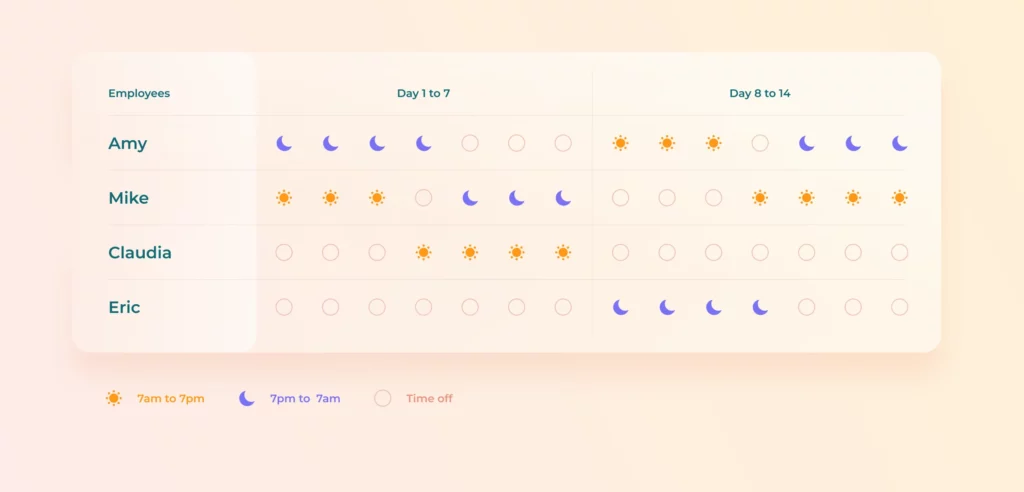
How the DuPont Schedule Works
The DuPont shift schedule follows a four-week cycle consisting of four stages.
- Stage 1: Employees work 4 consecutive night shifts then get 3 days off.
- Stage 2: Employees work 3 day shifts, get 1 day off, then work 3 consecutive night shifts.
- Stage 3: Employees get 3 days off then work 4 day shifts.
- Stage 4: Employees get 7 days off then the cycle restarts.
Pros of the DuPont Schedule
A DuPont schedule offers several benefits:
- Employees get a seven-day vacation every month, providing opportunities for socializing and family time.
- Night shifts are evenly distributed among teams, reducing the risk of dissatisfaction and burnout.
Cons of the DuPont Schedule
A DuPont schedule can also come with a couple of drawbacks:
- Shift coverage can be challenging if an employee is absent or gets sick.
- Each cycle includes a 72-hour long working week, which can be exhausting for workers.
Industries That Use the Dupont Schedule
Industries that commonly use a DuPont schedule include:
- Chemical
- Manufacturing
- Power
- Engineering
- Police
3. DDNNOO Schedule
What Is the DDNNOO Shift Plan?
The DDNNOO work schedule is another rotating shift schedule ensuring continuous 24/7 coverage. The name “DDNNOO” stands for “Day-Day-Night-Night-Off-Off.”
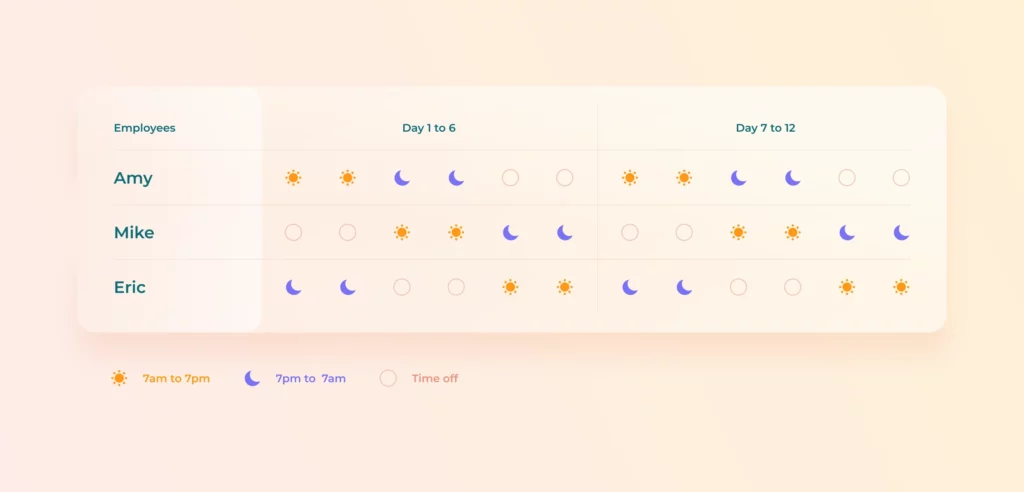
How the DDNNOO Shift Plan Works
In a DDNNOO shift schedule, three teams work through a six-day cycle of 12-hour workdays as follows:
- Work 2 day shifts
- Work 2 consecutive night shifts
- Get 2 days off
This continues in a repeat cycle.
Pros of a DDNNOO Shift Pattern
A DDNNOO shift pattern offers several benefits:
- Fewer teams working a longer shift length means fewer shift handovers, which facilitates communication and continuity.
- More flexibility and less risk of burnout, as employees regularly get both days and nights off, leading to a better work life balance.
- Requires fewer employees to achieve 24/7 coverage, which lowers labor costs.
Cons of a DDNNOO Shift Pattern
A DDNNOO shift pattern can also come with a few drawbacks:
- Irregular salary for hourly employees from month to month, since day shift and night shift wages often differ.
- Possible problems with labor regulations, particularly with respect to minimum mandatory work breaks for employees who work 12-hour shifts.
- Greater risk of workplace errors and injuries as jumping back and forth between day and night shifts can hinder sleep quality and lead to fatigue.
Industries That Use a DDNNOO Schedule
Industries that commonly use a DDNNOO schedule include:
- Manufacturing
- Hospitals
- Emergency services
- Police departments
- Restaurants
- Transportation services
6 Tips to Get the Most of a 2-2-3 Shift Schedule in Your Organization
1. Consider Employee Shift Preferences
When scheduling shifts, aim to set shift start times to reflect people’s natural productivity levels and what your team members prefer with respect to shift sequences and assigned shifts.
2. Take Breaks Seriously
Build productive breaks in your shift plan and make sure employees take them. This will increase productivity and reduce stress levels.
3. Use Software to Automate Shift Scheduling
Automating shift scheduling with workforce management software will eliminate the complexities of different teams working different shifts on different days and weeks.
4. Help Workers Adapt
Promote a life-work balance for employees. Employees unused to a 2-2-3 work schedule will need time to adapt. Keep the lines of communication open with employees and be sure to provide clear and detailed work instruction to ease the strain during the transition period. Pairing new hires with a more experienced employee can help.
5. Help Employees Remain Alert & Safe During the Night Shift
Install adequate lighting in the workplace to help employees stay alert and focused when working the night shift. This will reduce the risk of workplace accidents and injuries. Also install adequate lighting in the employee parking lot, outdoor employee break areas, and in pedestrian areas to ensure their safety.
Avoid exposing employees to too much light, though, as this can be irritating to the eyes over longer shifts.
6. Promote Healthy Shift Work Habit
Employees who rotate shifts frequently between day and night shifts can often pick up bad habits to make up for a lack of sleep.
- Recommend less caffeine intake, which can disrupt normal wake-sleep cycles.
- Give employees access to healthy beverages and snacks during breaks.
- Set up a napping area to increase employee efficiency and productivity, especially during consecutive night shifts. Even a 15- or 20-minute nap can help employees feel refreshed.
Download one of our free work schedule templates.
Conclusion
The 2-2-3 shift schedule or Panama shift schedule can be a great choice for businesses that require 24/7 staff coverage. It offers benefits not only to business owners but also to their employees, such as improved productivity, better work life balance, and more free time.
If you are looking for a shift work schedule that can bring positive changes to your workplace, the 2-2-3 work schedule is worth considering. If you decide to implement a 2-2-3 schedule, we hope the above tips will come in handy.
What Is a 2-2-3 Schedule?
A 2-2-3 work schedule is a shift work schedule commonly used in industries such as healthcare, emergency services, and manufacturing, where employees work for a set number of days or nights and then have a set number of days off. This pattern repeats over a period of weeks or months, depending on the specific work schedule in place.
For example, an employee might work a 12-hour day shift on Monday and Tuesday, have Wednesday through Friday off, work a 12-hour night shift on Saturday, Sunday, and Monday, and then have Tuesday and Wednesday off, before repeating the cycle again.
This type of schedule gives businesses 24/7 coverage while giving employees work-life balance to minimize fatigue and the risk of burnout.
What Are the Pros and Cons of a 2-2-3 Schedule?
Pros:
- Extended time off: Employees can enjoy extended periods of time off, which can help improve work-life balance and reduce stress.
- Consistency: A 2-2-3 work schedule offers a predictable pattern of work and time off, which can make it easier to plan personal activities and appointments.
- Reduced burnout: Employees have more time off to rest and recover, reducing burnout and increasing productivity.
- Continuous business operations: This schedule provides the business continuous staffing coverage as employees work in overlapping shifts.
Cons:
- Longer shifts: Burnout prevention is a major area of concern in any shift work scenario. A 2-2-3 work schedule often requires employees to longer workdays to cover the same amount of time as a traditional 8-hour shift.
- Difficulty transitioning: Some employees may find it challenging to transition from long workdays to multiple days off and vice versa.
- Limited flexibility: Employees may have limited flexibility to adjust their schedule or take time off, as the schedule is predetermined.
- Less quality time with family and friends: Depending on the nature of the work, employees may miss out on spending time with family and friends on weekends or holidays.
- Impacts on health: Not all employees adapt well to working night shifts. Too little light exposure can impact the human circadian rhythm and overall well being.
Overall, the 2-2-3 work schedule can be an effective way to balance work and personal life, but it may not be suitable for everyone. Employers should consider if the shift pattern works well for their specific team. Factoring in what employees prefer can boost employee morale.
What Are the Variations of a 2-2-3 Schedule?
There are several variations of a 2-2-3 work schedule, each with its own unique pattern of work and time off. Some common variations include:
- The DuPont Schedule
- The Pitman Schedule
- The DDNNOO Schedule
These variations can be adjusted to suit the needs of a particular industry or workplace, but they all share the basic idea of providing employees with a predictable pattern of work and time off. Employers should carefully consider the benefits and drawbacks of each variation before choosing the most suitable one for their organization.
How to Manage a 2-2-3 Schedule in My Organization?
Managing a 2-2-3 work schedule can be challenging for business owners, but there are several strategies that can help:
- Establish clear guidelines: Employers should clearly communicate expectations for employees regarding their work hours, breaks, and time off.
- Monitor employee performance: Employers should closely monitor employee performance and attendance, particularly when employees begin any new shift pattern, to ensure that they are meeting productivity and attendance goals.
- Provide training: Employers should provide training to employees to ensure that they understand the schedule and how to manage their time effectively.
- Use scheduling software: A team manager can reduce the average hours they spend on administrative tasks with employee management and scheduling software. Such software can be used to create and manage the schedule, which can help to avoid conflicts and ensure that employees are properly scheduled.
- Address concerns: Employers should be responsive to employee concerns and feedback about the schedule, and work to address any issues that arise. A team manager should keep an eye out for low employee morale or productivity as team members adjust to a new work and sleep cycle.
- Consider employee preferences: Employers should consider employee preferences when creating the schedule, such as accommodating employees with specific needs or preferences.
- Build flexibility into your shift pattern: Employees should be able to switch shifts when needed.
- Evaluate the schedule regularly: Employers should evaluate the effectiveness of the schedule regularly and make adjustments as needed to ensure that it is meeting the needs of the business and employees.
By implementing these strategies, employers can effectively manage a 2-2-3 work schedule and help to ensure that their employees are productive, satisfied, and engaged in their work.






